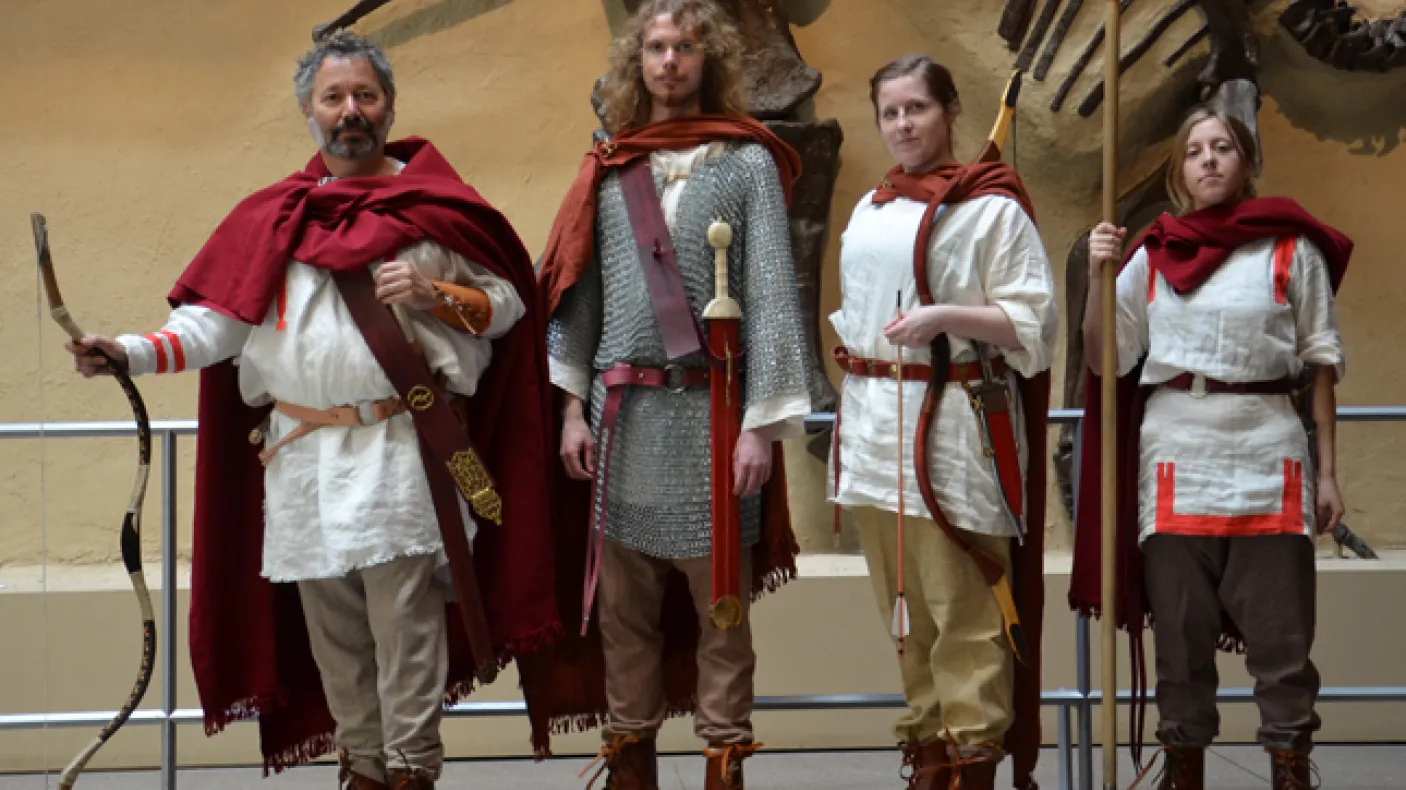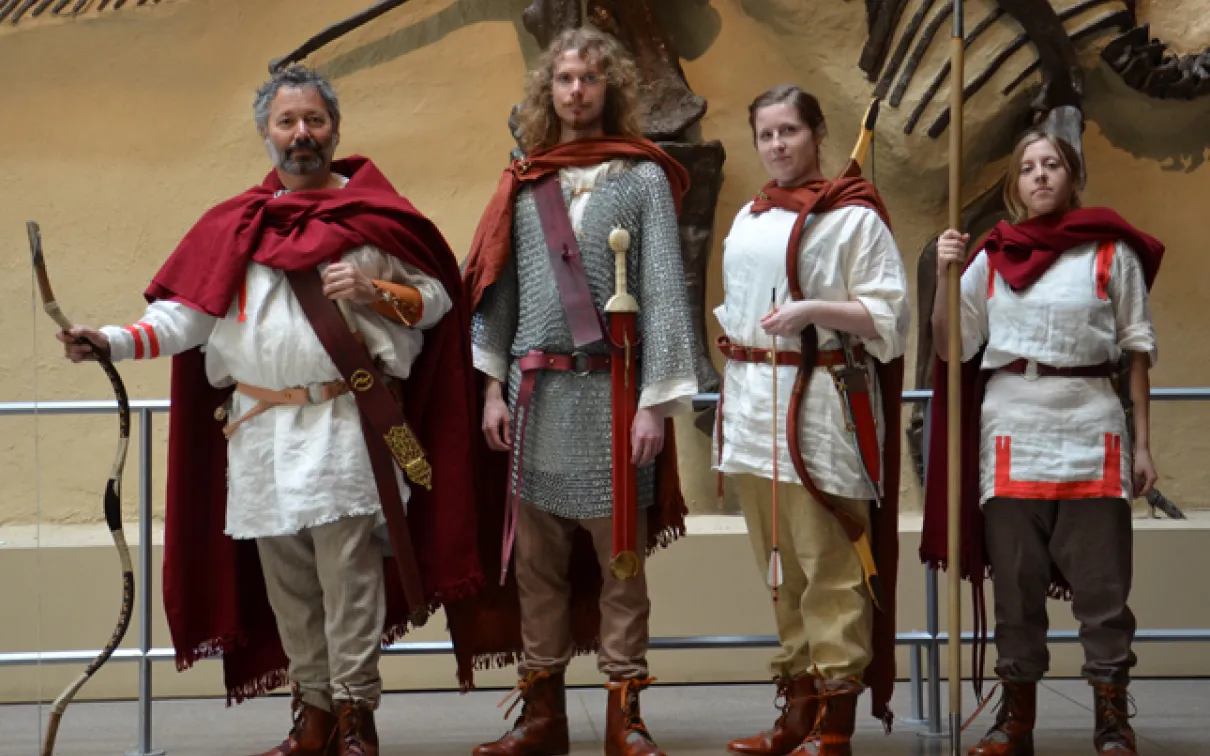Re-enactment, Archaeology, and the Ancient Rome & Greece Weekend V of IV: The Final Story
Published
Categories
Author
Blog Post
Ancient Rome & Greece Weekend is over, and I thought I would show you the results of my attempt to create a recreation, re-enactment, or impression of a soldier from Dura-Europos (so this is not really one of the original IV, so to speak, hence it is V of IV). In the group above you can see me on the left, with members of the University of Toronto's Hart House Archery Club, who collectively constitute the ROM's 3rd century Roman army (or ROMan army - it being the ROM, we are posing in front of a dinosaur). The others are wearing the tunics I had made last year for a similar weekend event, for which I asked Gwen Nowrick of Black Swan/Historic Enterprises to make me something that looked like the tunics worn by Terentius and his men. This year *I* am wearing the reproduction of an actual tunic from the period. The tunic is much longer, it would go down to my ankles unbelted, but it passes pretty well as a short tunic (see the previous blog to see how!).
Our trousers are reproductions leggings from what was Thorsbjerg Mose in Denmark when they were found in the mid-19th century (now in Germany and called Thorsberg Moor). The deposits there date from circa 100-500 AD, but the leggings are a very rare example of the period, so it is the closest example of what could possibly be Viking-era leggings, and in fact Gwen already sells them for use by Viking re-enactors. They look a bit baggy on us, compared to the clean lines of Terentius and his men, possibly because I did not want to wear trousers with feet! The original Thorsbjerg Mose find had feet, but trousers with feet are really annoying! We should probably fix that before next time, or at least the appearrance!
The cloaks are from last year and are wool, and red. This is probably wrong. Terentius and some of the others actually had a white cloak, and the others may have had brown cloaks. Both the white and dark were probably undyed wool, as undyed wool retains the lanolin, and would thereby be waterproof. I'm not happy with how the cloak looks. I put it on in the morning, looking in the mirror, and it looks right, but within a few hours it falls apart. I obviously need to work on that! It has a very interesting swish when you walk, like the swirl of a kilt, which is accentuated when you walk with a bit of a swagger. I can see why the soldiers wore it at all times!
The boots, the metal parts of my sword's shoulder-strap, the belt on Michelle (3rd to the right), and the sword on Julian (next to me) are from Armamentaria. The belt hardware on the other belts are made with parts from the local leather store.
As you can see from the photo of the ROMan army, the daggers are not very obvious, even the Künzing-style pugio on Halina, the ROMan soldier on the right (Michelle's is quite obvious, but she is not standing in the way the depictions of this period are). The horizontal hanging of my dagger made it very versatile. There are a number of ways to hold a dagger or knife in fighting, as may be seen in the photo-collage below.
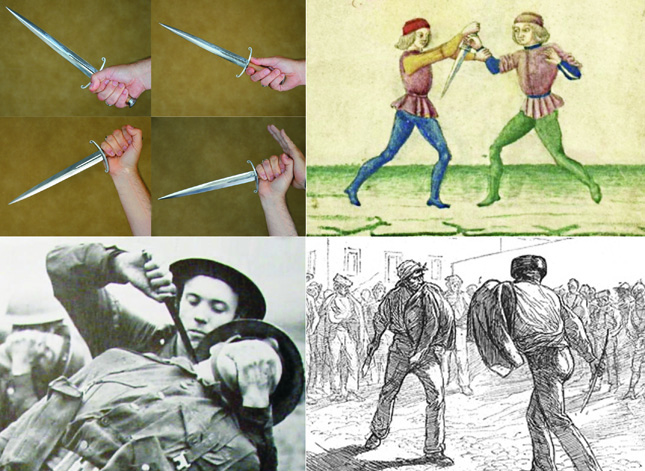
This photo-montage shows various dagger grips. The four images in the top left are the "hammer" forward grip (top left), the "fencer's" forward grip (top right), the "ice-pick" reverse grip (bottom left), and the same grip re-inforced by the other hand, a very effective style designed to pierce armour. The period depictions of knife-fighting show a late-mediaeval treatise with the "ice-pick" reverse grip (top right); a Commando from the 2nd World War training in the Fairbairn style with the Fairbairn-Sykes knife in a forward "hammer" grip; two duelers in the Spanish style of knife-fighting using a "fencer's" forward grip. The fencing grip works for dueler's wishing to cut each other enough to settle a dispute, the other styles are more suited to move in fast and kill someone.
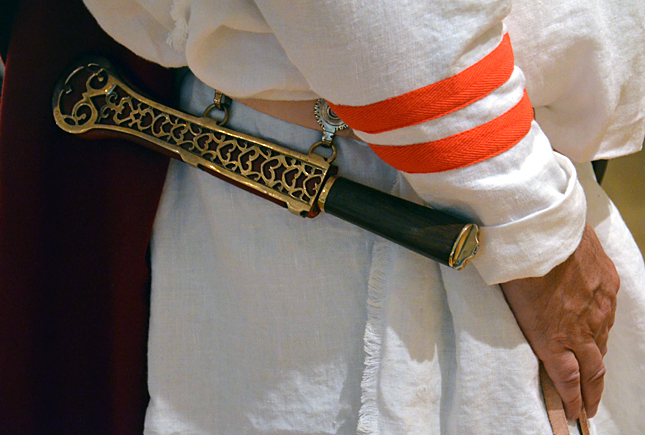
The knife in its scabbard hanging from the belt. The most obvious grip in this position would be the "hammer" reverse grip.
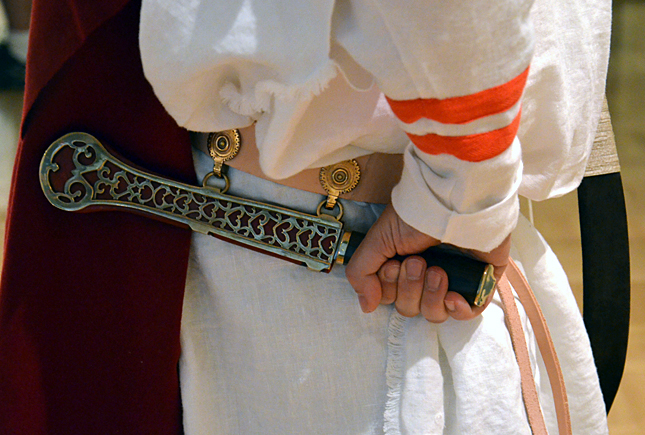
However, the knife could be drawn in a forward grip if one so wished - even with the left hand by reaching across the body (easier for a Roman soldier who would be slimmer than me, I imagine!).
With the scabbard hanging horizontally on my right side it would obviously be very easy to draw it in the "ice-pick" reverse grip, but by turning my hand it could also be drawn in a forward grip, whether the "hammer" (for falling with deadly intent on an unarmoured opponent) or the "fencing" grip (for persuading an opponent in a duel that he should take back what he just said about my mother). The pugio is typically depicted in the hammer grip, and so would be very well suited for a thrust into an unarmoured opponent in which the breadth of the blade would create the haemorrhaging that would cause death, death being an important objective in military knife-fighting. Even in the present day this form of grip is the most common in knife-attacks. The ice-pick reverse grip is by far the strongest grip, but it seems to only be typical in depictions from the mediaeval period, in fact there are entire treatises filled with depictions of knife fighting in which the ice-pick grip is predominant. The hammer grip came back into fashion in the post-mediaeval era, for example it was the grip advocated by the renowned knife-fighter William Fairbairn. The reason that the ice-pick grip was an important dagger-grip in the mediaeval period is probably due to the presence of extensive armour on the battle-field, and the dagger- or knife- training was designed to be prepared for that. If so, the shape of the knife I had recreated is again relevant, since I suggested in the previous blog about the knife that the shape of it may have been designed to get through or around armour. The easiest way to draw this knife would be in the grip most effective for piercing armour.
So that's it for another year! I shall see what improvements I can make in the kit of the ROMan army for next years Ancient Rome & Greece Weekend!
I would like to acknowledge the advice provided by Prof. Simon James in this project, and that of Tod and Gwen, although all mistakes are, of course, my own!
Previous blogs on the Dura-Europos re-enactment:
- I of IV: Introduction
- II of IV: The Sword
- III of IV: The Dagger
- IV of IV: The Tunic
